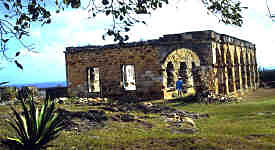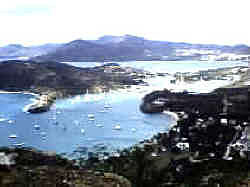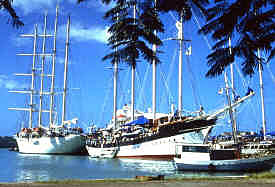ANTIGUA |
|
Harlan Hague |
It's been said that the first day of a trip sets the tone of the entire holiday. I keep hoping that's not true.
Take my trip to Antigua. Our landlady met our plane at 10:00 p.m., as planned. She had come to the airport at 4 p.m., she said, to pick up my brother. In fact, he arrived with my wife and me and two friends. He had written her about the change, but she had not received the letter, she said. No harm done.
We collected our luggage and headed for her van. Hold on there, said a taxi driver, you can't do that! Only licensed taxis can carry passengers from the airport! Our landlady backed off, and the five of us were wedged with our luggage into a taxi.
We arrived at our lodging, a tidy row of apartments. I awaited instructions. There's been a bit of a change, our landlady said.
My wife and I would share a two-bedroom apartment with our friends. What happened to our confirmed reservation for one single and two doubles? Well, these young men from France had come in, she said, they had no place to stay, and they were so nice, so what could I do?
The place was well named: Murphy's Apartments.
Not to worry. The breakfasts were delicious, the garden patio was green and inviting, I saw my first yellow-breasted banaquit, and Mrs. Murphy was a character. The accommodation was satisfactory and inexpensive ($35 single, $55 double), and the Waggenhoffers are still friends. The ambiance was Antiguan, including a nocturnal serenade by assorted dogs, goats, roosters, donkeys, and tree frogs. The rum punches and margaritas at the nearby Crazy Cactus Cantina softened all edges.
Antigua was settled in 1632 by English settlers from St. Kitts, and the island remained British until after World War II. The confederation of Antigua and nearby Barbuda in 1981 became an independent monarchy which recognizes Queen Elizabeth II as head of state. Member of both the Organization of American States and the British Commonwealth, the state acknowledges tradition and also looks to the future.
Begin a visit to Antigua at St. John's, the capital and largest town. A well-planned half-day will suffice, more if you are a shopper. Visit the impressive Anglican St. John's Cathedral, dating from 1683. The present building was begun in 1843 after an earthquake destroyed the former structure. An older building of historic importance is the Old Court House. Built in 1747, it now houses the Museum of Antigua and Barbuda with collections ranging from the native Arawaks to the post-World War II era.
If you must fill your precious holiday hours with shopping, visit the cool, modern, upscale and expensive duty-free shops in Heritage Quay, near the cruise ship pier. Redcliffe Quay is more interesting. Shops and restaurants are housed in restored warehouses and smaller structures dating from the eighteenth and nineteenth centuries. One can find some Antiguan products--rum, clothing, ceramic ware, rum, wooden carvings, straw work, rum, costume jewelry of shells and coral, and rum--but most goods offered for sale are imported.
A visit to the public market where local fruits, vegetables, and meats are displayed, can be fun, especially on Friday and Saturday mornings. Have lunch at the second-story Hemingway's Restaurant. If you enjoy people-watching, get a table on the verandah overlooking the street. Don't look for Papa Hemingway. The restaurant's brochure explains that this is "the kind of place frequented by the celebrated author."
The best part of the island is outside St. John's. One day will provide a sampling, but a two-day excursion is better. Distances are short, but stops are frequent. Drive your own rental car, or negotiate a tour by taxi. It's not as expensive as you might think.
Here are some suggestions, moving roughly clockwise around the island. Drive east from St. John's to Parham which was settled in the seventeenth century. The octagonal St. Peter's Anglican Church, built in 1840, is important in the ecclesiastical and architectural history of Antigua. On nearby Fitches Creek Bay, visit St. George's Church. The mid-nineteenth century Anglican church is interesting, and the view of the bay is striking.
Something of Antigua's early sugar industry can be seen in two restored estates. In the interior, Betty's Hope, dating from 1674, is one of the largest of the old sugar plantations and the most interesting that is open to the public. Continuing to the coast, visit the restored estate buildings of an 1843 sugar mill at Harmony Hall on Nonesuch Bay which house an art gallery, displaying works by local artists, and a restaurant and bar. At the southeastern extremity of the island, the beach at Half Moon Bay may be the most beautiful of the island's reputed 365 beaches.
The south coast is the most interesting and scenic region of Antigua. Visit the
historic sites on Shirley Heights first. The extensive  ruins and restored British military buildings, collectively called The
Blockhouse, overlook the coast and harbor. Most date from the late eighteenth century. The
panoramic view from windswept Cape Shirley, four hundred feet above the sea, is memorable.
The ruins are as romantic and melancholy as any I have seen, and I was quite moved by
them.
ruins and restored British military buildings, collectively called The
Blockhouse, overlook the coast and harbor. Most date from the late eighteenth century. The
panoramic view from windswept Cape Shirley, four hundred feet above the sea, is memorable.
The ruins are as romantic and melancholy as any I have seen, and I was quite moved by
them.
Nearby Fort Shirley also is ruined, with the exception of the ordnance building which has been restored and houses a restaurant, bar, and gift shop. It's the place to be on Sunday when entertainment features a steel band, 3-6 p.m., and a reggae band, 6-9 p.m. It's the place not to be on Sunday if you don't like crowds.
Walk through the restaurant to the gun platform, scattered now with picnic tables. The view from the edge is one of the most dramatic in the West Indies, and probably the most photographed. Five hundred feet below lie the historic English Harbour and Nelson's Dockyard. Sunsets from the platform are something to write home about and come back to.
Before leaving Fort Shirley, walk down to the ruined hospital above Nanton Point. Stop on the trail at the cemetery and ponder the fate of the lonely young men, like soldiers of every generation and many countries, who died in their country's service and were buried far from home.
En route to English Harbour, stop at Clarence House, the official country residence of the Governor-General. Built in 1787, it is a delightful example of a Georgian house, adapted for life in the West Indies, and authentically furnished and decorated in period style.
 The Royal Navy began using English Harbour in the
early eighteenth century. Naturally protected from hurricanes, the English in 1704 built
Fort Berkeley, now in ruins, on the point to protect against foreign marauders. The
dockyard, begun in 1743, served the Royal Navy until the late nineteenth century.
The Royal Navy began using English Harbour in the
early eighteenth century. Naturally protected from hurricanes, the English in 1704 built
Fort Berkeley, now in ruins, on the point to protect against foreign marauders. The
dockyard, begun in 1743, served the Royal Navy until the late nineteenth century.
Associating the facility with the famous English admiral, whose ship was stationed in the Leeward Islands, 1784-1787, is ironical. Nelson lost no love on Antigua and the Antiguans. He called English Harbour "a vile spot" and "this infernal hole." That's show biz. The carefully restored buildings in the Dockyard are worth a leisurely visit. Popular today with yachtsmen, the harbor is busier than ever.
Above English Harbour, visit the ruined Great George Fort, also known as Monks Hill Fort. Inquire locally about the condition of the road to the fort. Constructed in the late seventeenth century, the huge fort was designed to protect local inhabitants during attack. The view of the harbor below is alone worth the visit.
Continuing westward, the Fig Tree Drive from Liberta to the coast is one of the most scenic on the island. The road passes through lush rain forest on rolling hills, dotted with banana groves and huge mango trees. Ruined sugar mills and picturesque little churches evoke old Antigua. Occasional pineapple and coconut plantations border the coastal road. If you fancy a moderate hike of a half hour or so, climb to the top of Green Castle Hill, south of St. John's, for a magnificent view.
Other pleasures offered by Antigua include casinos, tennis, deep sea fishing, swimming, snorkeling, and scuba diving. The island is one of the
premier sailing destinations in the Caribbean. Accommodations range from flats and
apartments to luxury beach hotels.
tennis, deep sea fishing, swimming, snorkeling, and scuba diving. The island is one of the
premier sailing destinations in the Caribbean. Accommodations range from flats and
apartments to luxury beach hotels.
For information on Antigua, write to Antigua & Barbuda Department of Tourism, 510 Fifth Avenue, Suite 311, New York, NY 10020, or call (212) 541-4117. Immediately on arrival, buy a copy of Antigua and Barbuda: Heart of the Caribbean, by Brian Dyde. If the packet from the tourist bureau does not include a good map of the island, buy one before venturing outside the city.
|
Caveat and disclaimer: This is a freelance travel article that I published some time ago. Some data, especially prices, links and contact information, may not be current. |
|
|
|
|